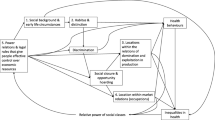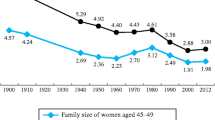Abstract
The social class of adult adoptees is found to correlate with that of their nonadopted biological full and half-siblings, suggesting a genetic contribution to the determination of social class: it also correlates with that of their adoptive parents' biological children with whom they are reared, i.e., adoptive siblings, indicating an effect of the familial environment. The mean social class of adoptees lies above that of their nonadopted biological siblings, again indicative of an effect of the adoptive familial environment. Both the correlational and the mean level findings constitute a confirmation of earlier reports.
Similar content being viewed by others
References
Bouchard, T. J., and McGue,M. (1981). Familial studies of intelligence: A review.Science 212:1055–1059.
Frane, J. (1981). PAM: Description and estimation of missing data. In Dixon, W. J., and Brown, M. B. (eds.),BMDP-81: Biomedical Computer Programs, P-Series, University of California Press, Los Angeles.
Jencks, C. (1972).Inequality, Basic Books, New York.
Loehlin, J. C. (1980). Recent adoption studies of IQ.Hum. Genet. 55:297–302.
Schiff, M., Duyme, M., Dumaret, A., and Tomkiewicz, S. (1982) How much could we boost scholastic achievement and IQ scores? A direct answer from a French adoption study.Cognition 12:165–196.
Sewell, W. H., and Hauser, R. M. (1975).Education. Occupation and Earnings, Academic Press, New York.
Stunkard, A. J., Sørensen, T. I. A., and Schulsinger, F. (1982). Use of the Danish Adoption Register for the study of obesity and thinness. In Kety, S. S., Rowland, L. P., Sidman, R. l., and Matthysse, S. T. W. (eds.),Genetics of Neurological and Psychiatric Disorders, Raven Press, New York.
Taubman, P. (1976). The determinants of earnings: Genetics, family, and other environments; A study of white male twins.Am. Econ. Rev. 66:858–870.
Teasdale, T. W. (1979). Social class correlations among adoptees and their biological and adoptive parents.Behav. Genet. 9:103–114.
Teasdale, T. W., and Owen, D. R. (1981). Social class correlations among separately adopted siblings and unrelated individuals adopted together.Behav. Genet. 11:577–588.
Teasdale, T. W., and Owen, D. R. (1984). Social class and mobility in male adoptees and nonadoptees.J. Biosoc. Sci. 16:521–530.
Teasdale, T. W., and Sørensen, T. I. A. (1983). Educational attainment and social class in adoptees: Genetic and environmental contributions.J. Biosoc. Sci. 15:509–518.
Author information
Authors and Affiliations
Rights and permissions
About this article
Cite this article
Teasdale, T.W., Sørensen, T.I.A. & Owen, D.R. Social class in adopted and nonadopted siblings. Behav Genet 14, 587–593 (1984). https://doi.org/10.1007/BF01068129
Received:
Accepted:
Issue Date:
DOI: https://doi.org/10.1007/BF01068129




